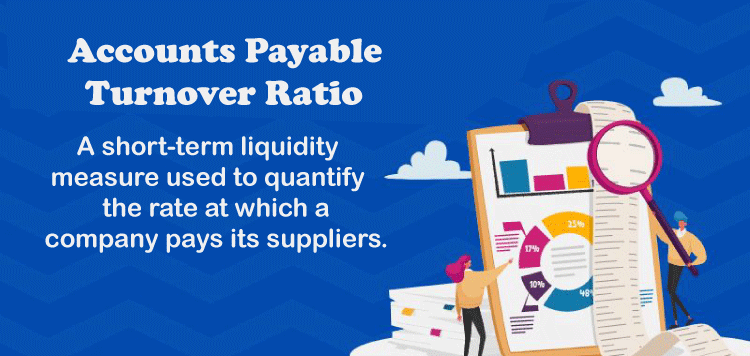Accounts Payable Turnover Ratio DefinitionWhat exactly is the Accounts Payable Turnover Ratio?It is a measure of short-term liquidity that helps determine the pace at which a firm repays its suppliers. Accounts payable turnover shows how frequently a firm pays off its accounts payable within a given time. 
Accounts payable are a business's short-term obligations to its suppliers and creditors. The accounts payable turnover ratio shows how well a firm pays its suppliers and clears short-term obligations. In-depth Understanding of Accounts Payable Turnover RatioThe accounts payable turnover ratio reflects investors, the company's short-term liquidity, and, to a lesser extent, its creditworthiness. A high ratio shows that suppliers are paid on time for credit purchases. A high number might be attributed to vendors getting prompt payment. This could mean that the firm is trying to take advantage of early payment incentives or raise its credit rating. A low ratio suggests late payment to suppliers for credit purchases. This might be owing to critical lending conditions, or it could indicate cash flow issues and, as a result, a worsening financial situation. While a declining ratio may signal a firm's financial trouble, this is not always true. The corporation may successfully negotiate improved payment conditions, allowing it to pay less often without penalty. The credit conditions of a company's suppliers frequently influence its accounts payable turnover ratio. For example, companies with advantageous lending conditions typically report a lower ratio. Big corporations with negotiating leverage who can obtain better credit conditions would reduce the accounts payable turnover percentage. Although a high accounts payable turnover ratio is typically beneficial to creditors as an indication of trustworthiness, businesses should also take advantage of credit periods given by suppliers to receive discounts on purchases. Like other financial measures, a company's turnover ratio is best analyzed compared to similar organizations in its sector. For example, a company's payables turnover ratio of two will be more alarming if nearly all of its rivals have a ratio of at least four. Decoding Accounts Payable Turnover Ratio
The accounts payable turnover ratio informs investors how frequently a business pays its accounts payable. In other terms, the ratio assesses how quickly a firm pays its suppliers. Accounts payable are represented as current liabilities on the balance sheet. The accounts payable turnover ratio can be used by investors to analyze if a firm has enough cash or income to cover its short-term obligations. Creditors can use the ratio to determine whether to grant the firm a line of credit. A Decreasing AP Turnover RatioA decreasing turnover ratio suggests that a corporation takes longer than usual to pay its suppliers. The rate at which a firm pays its debts may indicate the company's financial situation. A decreasing ratio might indicate that a corporation is in financial trouble. A decreasing ratio might indicate the corporation has negotiated alternative payment arrangements with suppliers. An Increasing Turnover RatioAs the turnover ratio increases, this indicates that the corporation pays out its suppliers more quickly than before. An increasing ratio indicates the corporation has enough cash to pay its short-term debt on schedule. Consequently, an increased accounts payable turnover ratio suggests that the firm efficiently manages its obligations and cash flow. Nevertheless, an increasing ratio over time may indicate that the company has no desire to invest money back into its business, which may result in lower growth rates and profitability over the long term. A corporation should create enough income to pay off its accounts payable fast but not so rapidly that it misses out on possibilities since that money may be used to invest in other ventures. What is the formula for the Accounts Payable Turnover Ratio?The accounts payable turnover ratio is calculated as follows: Payable Turnover Ratio = Net Credit Purchases/Average Accounts Payable In certain circumstances, the cost of goods sold (COGS) is utilized in the numerator in place of net credit purchases. Accounts payable, on average, are the total of accounts payable at the beginning and end of an accounting period divided by two. Accounts Payable Turnover Ratio ExampleLet's say a company named JTP reported annual purchases on the credit of $123,555 and returns of $10,000 during the fiscal year ending December 31, 2022. Accounts payable were $12,555 and $25,121 at the beginning and end of the year, respectively. The company wants to count the number of times it paid its debtors during the fiscal year. Payable Turnover Ratio = [$123,555 - $10,000] / [($12,555 + $25,121)/2] = 6.03 Hence, throughout the fiscal year, the company's accounts payable turned over about 6.03 times. The turnover ratio would most likely be rounded up to six. Limitations of AP Turnover RatioComparing a company's ratio to other firms in the same industry is advisable, like any financial ratio. Each industry may have a standard turnover ratio specific to that business. A ratio limitation might occur when a firm has a high turnover ratio, which creditors and investors view as a favourable development. Assume the ratio is much greater than that of other firms in the same industry. In that instance, it might imply that the firm is not investing in its future or effectively using its cash. Overall, a high or low ratio should not be regarded at face value. Nevertheless, such a ratio prompts the investors to consider the important reasons involved for a high or low ratio and arrive at a conclusion after analysis. Why is it used in Financial Modeling?The accounts payable turnover ratio (or turnover days) is an important assumption in financial modelling when producing the balance sheet projection. The accounts payable balance is determined on the premise that the cost of goods sold (COGS) is paid within 30 days (on average). To calculate the AP balance, multiply COGS in each period by 30 and divide by the number of days. How to determine Accounts Payable Turnover Ratio in Days?The company and industry benchmarking determine a decent accounts payable turnover ratio in days. In general, the average credit term days obtained from the vendors and the company's payment scheduling standards help determine AP turnover. Rules must support vendor relationships, a solid credit history, and ongoing supplier inventory shipments. Days payable outstanding (DPO) is another term for accounts payable turnover in days. Based on the average number of days in the turnover period, it's a new take on the accounts payable turnover ratio calculation. The DPO formula is obtained by dividing the days in the recorded period by the AP turnover ratio. The DPO should adequately relate to average credit payment terms given in days until the payment is due and any early payment discount rate provided. AP Turnover vs. AR Turnover RatiosThe accounts receivable turnover ratio indicates how rapidly a firm receives payment from its consumers. In contrast, the accounts payable turnover ratio indicates how quickly the company pays its suppliers. The accounts receivable turnover ratio is an accounting measure used to assess a company's ability to recover receivables, or money customers owe. The ratio demonstrates how successfully a firm operates and maintains its consumer credit and how fast short-term debt is recovered or paid. The accounts payable turnover ratio calculates how quickly a firm pays its suppliers. Accounts payable turnover demonstrates how frequently a firm pays off its accounts payable within a given time. The Bottom LineThe AP turnover ratio is a form of financial ratio that measures how frequently a firm pays its suppliers by considering the entire cost of products sold over a given period, generally a month or a year. The KPI (Key Performance Indicator) helps evaluate the company's accounts payable, which reflects money owed to vendors and displays it as a current liability on the balance sheet (a short-term debt). Simply put, the AP turnover ratio measures a company's capacity to pay its short-term loans. It indicates its short-term liquidity (i.e., cash flow). The faster the firm pays off its debt, the greater the accounts payable turnover ratio. Accounts payable has traditionally been considered an important, but not huge, corporation element until the introduction of accrual accounting. Therefore, something like the AP turnover ratio isn't routinely analyzed, even on a company's radar. Yet, an increasing number of businesses are investing in software and resources to streamline the accounts payable function, which boosts the AP turnover ratio. |
 For Videos Join Our Youtube Channel: Join Now
For Videos Join Our Youtube Channel: Join Now
Feedback
- Send your Feedback to [email protected]
Help Others, Please Share










